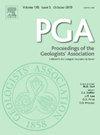Determining the relative scientific and cultural “value” of the UK's in-situ dinosaur track sites
IF 1.2
4区 地球科学
Q2 Earth and Planetary Sciences
引用次数: 0
Abstract
Dinosaur tracks (footprints) provide useful information on the palaeoecology and distribution of dinosaurs over time, complementing the skeletal (body) fossil record. These tracks are amongst the most popular and recognisable trace fossils in the natural world, attracting significant public interest and drawing visitors to sites in England, Scotland, and Wales. Beyond their scientific importance, they offer valuable aesthetic and educational opportunities in the tourism and education sectors. However, the protection, monitoring, communication, and scientific understanding of these sites vary widely. Here we review the nature of the fourteen in-situ dinosaur track sites present in the UK today, and subsequently use an established quantitative system to determine the relative scientific and cultural ‘value’ of each site. We find that the relative scientific and cultural value of UK track sites varies considerably, and that the two value types do not correlate with one another. UK sites with considerable national and international scientific value include the Late Triassic dinosaur track site Bendrick Rock, in South Wales, and the Middle Jurassic site Ardley Quarry, in Oxfordshire. By contrast, the Early Cretaceous dinosaur track sites at Hanover Point, Isle of Wight, and Spyway Quarry, Dorset have relatively high cultural value due to their accessibility and visitor appeal, but modest scientific value. This assessment helps identify threats and opportunities for UK dinosaur track sites, guiding future conservation, scientific research, and public engagement efforts.
确定英国原位恐龙足迹遗址的相对科学和文化“价值”
恐龙足迹(足印)提供了关于古生态学和恐龙随时间分布的有用信息,补充了骨骼(身体)化石记录。这些足迹是自然界中最受欢迎和最容易识别的痕迹化石之一,吸引了大量公众的兴趣,吸引了英格兰、苏格兰和威尔士的游客。除了科学上的重要性外,它们还为旅游和教育部门提供了宝贵的美学和教育机会。然而,对这些遗址的保护、监测、交流和科学认识差异很大。在这里,我们回顾了目前英国14个原位恐龙足迹遗址的性质,并随后使用一个既定的定量系统来确定每个遗址的相对科学和文化“价值”。研究发现,英国轨道遗址的相对科学价值和文化价值差异较大,两种价值类型之间不存在相关性。具有重要国内和国际科学价值的英国遗址包括南威尔士的晚三叠世恐龙足迹遗址本德里克岩,以及牛津郡的中侏罗世遗址阿德利采石场。相比之下,怀特岛汉诺威角和多塞特郡Spyway采石场的早白垩世恐龙足迹遗址由于其可达性和游客吸引力而具有较高的文化价值,但科学价值不高。这项评估有助于确定英国恐龙足迹遗址的威胁和机遇,指导未来的保护、科学研究和公众参与工作。
本文章由计算机程序翻译,如有差异,请以英文原文为准。
求助全文
约1分钟内获得全文
求助全文
来源期刊
CiteScore
2.70
自引率
8.30%
发文量
54
审稿时长
6-12 weeks
期刊介绍:
The Proceedings of the Geologists'' Association is an international geoscience journal that was founded in 1859 and publishes research and review papers on all aspects of Earth Science. In particular, papers will focus on the geology of northwestern Europe and the Mediterranean, including both the onshore and offshore record. Following a long tradition, the PGA will focus on: i) a range of article types (see below) on topics of wide relevance to Earth Sciences ii) papers on aspects of Earth Science that have societal relevance including geoconservation and Earth management, iii) papers on palaeoenvironments and palaeontology of the Mesozoic and Cenozoic, iv) papers on aspects of Quaternary geology and climate change, and v) papers on the history of geology with particular reference to individuals that have shaped the subject. These topics will also steer the content of the themes of the Special Issues that are published in the PGA.

 求助内容:
求助内容: 应助结果提醒方式:
应助结果提醒方式:


